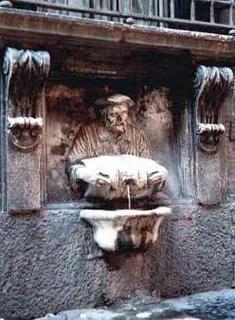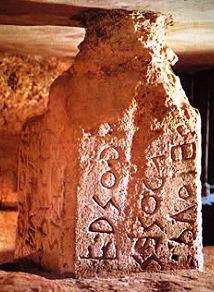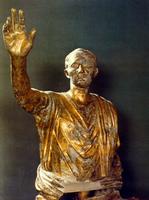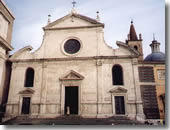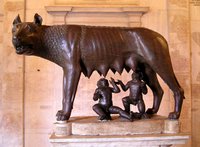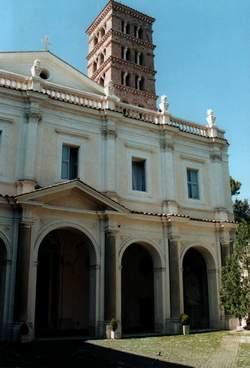
One the more interesting churches of Rome is surely Sant' Alessio on the Aventino. The memory of this roman saint has been officially cancelled from the calendar of the Church, but the memory of his saints actions keeped the cult alive through centuries: his history was drawed on the wall of the basilica of Saint Clemente, sung from cantors, put in poems from poets and in the 1634 became an opera of Stefano Lando. The legend begins from a lacked wedding: Alessio, lived in V the century, son of the senator Eufemiano and Aglae, in the day of his wedding with a rich roman girl he decided that it wasn't what he really wanted. After an explanatory talk with the future spouse, he left the beautiful parental home; dressed with only a poor robe, he started to travel. He arrived in Palestine where he lived of hand out. Then, after a lot of years, he decided to return in Rome. He knocked to the parental home, but - for the long beard and moreover he was older - he does not been recognized. Believing him a pilgrim, they offered him to lodge in a under the stairs of the palace. Here he lived seventeen years, nourishing himselves with the paternal charity and drinking the water of the close well (still today in full efficiency in the courtyard of the church). His true identity was revealed from a letter to the father, only when Alessio died. The Pope and the emperor saw in him "a man of God" and venereted him. The story tells that the bells of Rome, without any human touch, started to play itself and that in the palace there were wonderful fragances. The stairs, that were the roof of the saint for long years, it is keeped in a big glass reliquary in the church. In the roman tradition, Alessio is the Saint that tells the numbers to play to the lottery. In order to obtain the numbers, who addresses to Alessio must pray nine days and be awake on the house stairs, in memory of the mortification chosen from the saint. For more, post me. Dblk
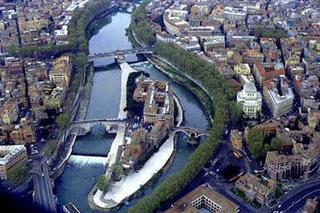 The isola Tiberina (island of the Tevere, the river of Rome) is situated in the old town centre. A legend tells that this island derives from a rebellion of Rome. Infact when the ancient romans sent away their king Tarquinio the presumptuous, his assests were chucked in the stream. After a pair of years the mud accumulate itself on those, creating the island. Another story of its creation narrates that this once was a warship sinked here. If you take a look to the picture you can see that it is similar to a vessel; moreover in the island there is an obelisk located to be something like a sailboat. But this island is also been known as a place to cure ills. That is because once in Rome, in the 293 b. C., there was the plague; so to remove it, came a boat from Epidauro (in Greece) bringing the snake of Esculapius (the god of the health and medicine: the snake was his hloy animal). When this
The isola Tiberina (island of the Tevere, the river of Rome) is situated in the old town centre. A legend tells that this island derives from a rebellion of Rome. Infact when the ancient romans sent away their king Tarquinio the presumptuous, his assests were chucked in the stream. After a pair of years the mud accumulate itself on those, creating the island. Another story of its creation narrates that this once was a warship sinked here. If you take a look to the picture you can see that it is similar to a vessel; moreover in the island there is an obelisk located to be something like a sailboat. But this island is also been known as a place to cure ills. That is because once in Rome, in the 293 b. C., there was the plague; so to remove it, came a boat from Epidauro (in Greece) bringing the snake of Esculapius (the god of the health and medicine: the snake was his hloy animal). When this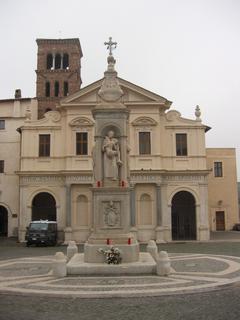 arrived in Rome the snake escaped from the vessel and put itself in the island waiting here for a while and then suddely disappearing. Romans took this event as a volunty of the god to stay here, so they constructed a temple for this divinity: a part of this is probably in the church of S. Bartolomeo. This building "de insula" infact(on the island), developed in the X century, has the well and some column of the ancient temple of Esculapio. About the church on the pediment there is written: "IN HAC BASILICA REQUIESCIT CORPUS S.BARTHOLOMAEI APOSTOLI" (In this basilica there is the body of the apostle S. Bartolomeo). A last thing: in this area there are today two hospitals, one of them was constructed form friars. A lot of people tells that here they saw a procession of hooded men walking and suddenly disappearing: someone thinks they are friars, but most probably they were members of a secret society that were buried here. For more, post me. Dblk
arrived in Rome the snake escaped from the vessel and put itself in the island waiting here for a while and then suddely disappearing. Romans took this event as a volunty of the god to stay here, so they constructed a temple for this divinity: a part of this is probably in the church of S. Bartolomeo. This building "de insula" infact(on the island), developed in the X century, has the well and some column of the ancient temple of Esculapio. About the church on the pediment there is written: "IN HAC BASILICA REQUIESCIT CORPUS S.BARTHOLOMAEI APOSTOLI" (In this basilica there is the body of the apostle S. Bartolomeo). A last thing: in this area there are today two hospitals, one of them was constructed form friars. A lot of people tells that here they saw a procession of hooded men walking and suddenly disappearing: someone thinks they are friars, but most probably they were members of a secret society that were buried here. For more, post me. Dblk 